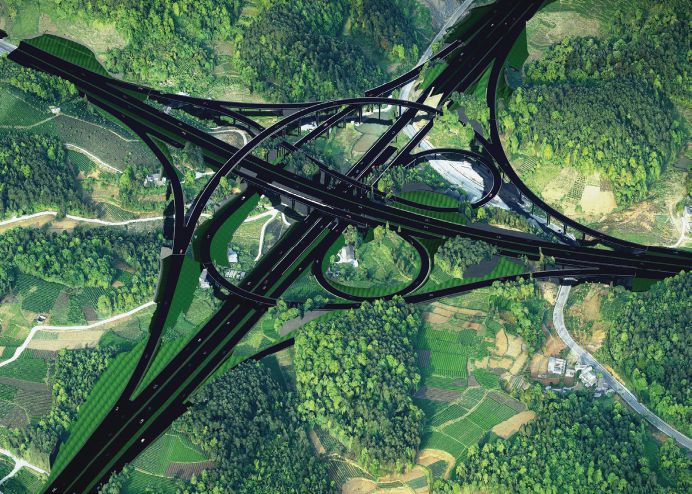Engineered Solutions: Digital Twins: The Backbone of Road Infrastructure Decision Making

Sponsored by:

Digital twins have become one of the most important technology trends for transportation infrastructure because of their potential to improve design, visually enhance collaboration, and increase asset reliability and performance. Digital twins can be considered the backbone of infrastructure decision making because they provide up-to-date information about projects, their status, and the risks associated with the project. Digital twins enable visualization of an asset across its entire lifecycle in order to track change and perform analysis to optimize asset performance.
What Are Digital Twins?
A digital twin is a digital representation of a physical asset, process or system as well as the engineering information that allows us to understand and model its performance. Plainly stated, a digital twin is a highly detailed digital model that is the counterpart (or twin) of a physical asset. Digital twins are continuously updated with data from multiple sources, which is what makes them different from static, 3D models.
Why Are Digital Twins Important?
From concept to operations, contractors, construction firms, and road and bridge owner-operators can leverage digital twins to gain better visibility for project teams, management and owners to understand the implications of design decisions early in the process and achieve improved performance across the asset lifecycle.
During the planning, design, and construction of a new road or bridge or major upgrade, project digital twins can enable the optimization of design in line with operational requirements and reduce the risk of delayed or nonconformant construction through simulation. Project digital twins can also improve logistics and communication within the supply chain, which can help maintain the schedule and budget.
During operations, performance digital twins become the most valuable. Owner-operators gain insight when inputs from Internet of Things (IoT) connected devices—such as drones that deliver continuous surveys to provide real-time tracking of asset changes in real-world conditions—add to the digital representation. This transparency helps owner-operators prioritize and improve maintenance or upgrades.
With the application of artificial intelligence (AI) and machine learning (ML), analytics visibility gained from big data can provide insight and immersive digital operations to enhance the effectiveness of operations and maintenance.
Road and Bridge Digital Twins in Action
Bentley sees its users “Going Digital” with digital twins to improve project delivery and/or enable assets to perform better, every day and all around the world.
BIM Advancements and Digital Twins Optimize Design and Construction of Chinese Expressway
Meitan-Shiqian Expressway is the first expressway in China to apply BIM methodologies for construction and management in large quantities and in all disciplines. Located in a very mountainous area, the expressway is 112.977 kilometers long with numerous bridges, elevated highways and tunnels.
The project leveraged digital twins to improve the quality of expressway construction and implement the concept of full lifecycle management. Unmanned aerial vehicles were flown to survey the existing site, and Bentley’s reality modelling software was used to create a 3D reality model. Having this reality context helped the team accelerate and optimize the design, shortening the construction period by 89 days.
The introduction of virtual design and construction technologies has transformed the traditional construction lifecycle on this project. The project team identified issues in the design stage that would not have been found and solved until the construction stage using previous methods. Identifying problems at the design stage cut the design effort and time in half, improved construction quality, and reduced construction costs. The BIM models collected during the project were used to establish a digital twin, which provides the foundation for maintenance, modelling and predicting future asset performance.

Meitan-Shiqian Expressway
Utilizing Digital Twins From Design Through Operations for Highway in Malaysia
Malaysia’s Pan Borneo Highway is a 1,060-kilometer, four-lane dual carriageway that spans existing communities and protected reserves in the state of Sarawak. Lebuhraya Borneo Utara (LBU), the project delivery partner, and Reveron Consulting, a Bentley partner, were selected by the government of Malaysia to implement Bentley solutions for design, construction and operations of the highway.
LBU digitized planning, design and construction of the Pan Borneo Highway, accommodating government standards to deliver best value. Having leveraged Bentley applications throughout construction, including for construction monitoring, the next phase focused on operations, maintenance, and asset management to ensure the highway meets its current and future functional requirements.
Capitalizing on reality modeling, as well as digital processes and workflows, a digital twins approach was used as the basis for operational decisions. Bentley’s integrated applications along with its connected data environment provide a complete technology solution that enables the creation of a digital twin. The digital twins integrate a road information system, a bridge management system and a maintenance management system. The digital twins use Bentley technology to combine BIM, reality modeling and GIS data to provide immersive visibility and analytics for timely decision-making and improved infrastructure asset performance.
Summary
Digital twins enable you to visualize infrastructure assets across the entire asset lifecycle, track change and perform analysis to optimize asset performance. Bentley’s infrastructure digital twins combine engineering data, reality data and IoT data for a holistic view of infrastructure above and below ground. Immersive visualization and analytics visibility help you achieve a deeper understanding of your infrastructure assets—so you make better-informed decisions for better outcomes.
About Todd Danielson
Todd Danielson has been in trade technology media for more than 20 years, now the editorial director for V1 Media and all of its publications: Informed Infrastructure, Earth Imaging Journal, Sensors & Systems, Asian Surveying & Mapping, and the video news portal GeoSpatial Stream.


